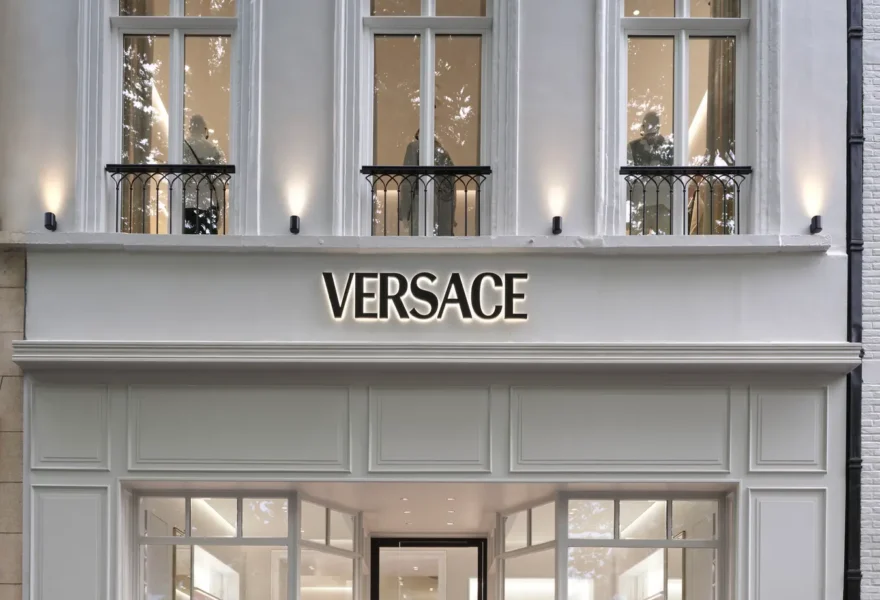The fashion value chain is notoriously long and complex. Consider, for example, the yarn’s journey, it begins as raw materials sourced globally, and transforms into a finished product available in various points of sale, both physical and digital. This journey involves multiple stages such as dyeing, weaving, cutting, sewing, packaging, and distribution, each managed by different entities across various countries. Each stage incurs specific environmental impacts, including farming, energy-intensive processes, and chemical consumption, all of which contribute to a company’s Scope 3 emissions footprint.
Aligning with the Science Based Targets initiative (SBTi) requires companies to set reduction targets encompassing at least 67% of total Scope 3 emissions, provided these emissions exceed 40% of their total environmental footprint, a common scenario in the fashion industry.
Versace recognises climate action calls for commitments to be delivered within and outside of the company’s direct operations, explicitly recognising the importance of stakeholder engagement to deliver them effectively.
Challenge
Supply chain relationships are crucial for Brands to ensure adherence to their long-term commitments – especially with regards to SBTi targets aimed at driving decarbonization efforts – and send a clear signal to the market across the entire value chain.
Versace worked with Quantis to engage certain key Suppliers – majority being Italian SMEs, belonging to five different sub-industries (footwear, tanneries, leather goods, textile, accessories) – in a data collection process for the calculation of these suppliers’ Scope 1&2 emissions with the ultimate goal of having suppliers set climate change targets in line with the indications of the Science-Based Targets initiative
Quantis supported each supplier with a tool to allow them to calculate their Scope 1&2 emissions autonomously for the years to come.
Solutions
Project driven by Quantis and Versace followed a series of workstream, such as:
Engaging value chain players on climate awareness:
- Engagement workshops to inform and create awareness on climate roadmap for the selected suppliers.
Engaging value chain players on first-hand impact calculation:
- Carbon footprint Scope 1 & 2: Quantis guided and assisted
collection of Scope 1 and 2 data from the selected suppliers + baseline carbon footprint (Scope 1-2) calculation. - Quantis arranged dedicated on-site visits to support on the data gathering process, with the goal of ensuring the best available data was used for the analysis
Engaging value chain players on SBTi submission and individual taking action:
- Hotspots evaluation & high-level reduction action plan: Based on CF Scope 1 and 2 results, there has been the identification of the main hotspots and a definition of high-level decarbonization plan per suppliers’ cluster.
- Simplified tool for Scope 1 & 2 calculation: Creation of a simplified tool to allow suppliers calculate their own scope 1&2 and training on how to properly use the tool.
- Science Based Targets: Calculation of suppliers’ climate change reduction targets in line with the SBTi & support for the SBTs submission, following the streamlined route for SMEs, for those suppliers who decided to take part in the initiative.
Results
Engaging the supply chain is essential for fashion brands to achieve ambitious sustainability goals and to meet the increasingly stringent transparency and traceability requirements imposed by global regulators. The scope and impact of supply chain engagement, along with the opportunities it presents, were clearly demonstrated by the results of this project.
As of the publication of this case study, 34 Versace suppliers were engaged in the two waves of the project.
While it was the first time gathering environmental data for some selected suppliers, they now recognise the importance of an established collection process, given how relevant it is going to be in the years to come.
The project also helped them create internal data collection systems to face future management challenges and requests from brands.
Each of the supplier has received their Carbon Footprint results across multiple recent years and were provided access to a dedicated e-tool. Additionally, suppliers have received their SBTs projections, together with an explanation of the levels of ambition and a step-by- step guide on how to submit their targets.
Each supplier received an action plan showcasing what initiatives could be implemented from here to 2030 to enable them to achieve their climate change reduction targets.
For each action, Quantis provided a quantitative estimate of contribution to the emission reduction potential. The action plans were tailored by cluster, given the different nature of the respective business activities.
Out of the more than 8 thousand companies who so far have taken climate actions via the Science Based Target initiatives (SBTi), currently more than 500 are from the Fashion and Sporting Goods sector.
Thanks to the first wave, ended in 2023, 9 Versace suppliers have eventually been submitted on SBTi platform their SMEs science-based target reduction.
We’re your full-service partner for the transformational journey. Our strategic advisors are equipped to guide you at every point along the way.



